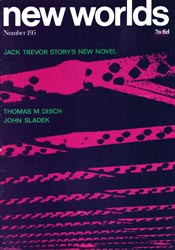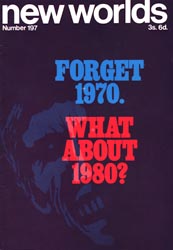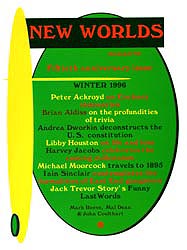|
|
|
STORY IN NEW WORLDS |

 |
|
LEAD-IN (EDITORIAL, NEW WORLDS no.195) |
|
JACK TREVOR
STORY is probably already familiar
to most readers as the author of the Albert Argyle trilogy (Live Now, Pay Later, Something for Nothing and The
Urban District Lover), The Trouble With Harry (on which Hitchcock
based his well-known film), or his first Horace Spurgeon Fenton book, I
Sit in Hanger Lane. Until recently Story’s work has been
predominantly of the kind that might be called comic naturalism — its
subject matter drawn from his own experience of the London suburbs and
the New Towns — but with his second Horace Spurgeon Fenton novel, One
Last Mad Embrace (which Allison and Busby will publish in the new
year) [1970] he has added a strong element of fantasy and his concerns
have been growing increasingly similar to the concerns of the kind of
writers who are usually published in NEW
WORLDS. Like One Last Mad
Embrace, his new novel The
Wind in the Snottygobble Tree takes much of its subject matter from
the larger canvas of world events, investigating and utilising many of
our current totem-figures and questioning our attitudes towards them.
Story’s talent for comic writing remains as strong, but he has
refocussed it to analyse, like J.G, Ballard, the mythology of the
present day. How can we separate the truth from the fiction in our
newspapers and television programmes? What, in fact, is truth, at what
point does fiction actually begin to become truth? These are some of the
concerns of The Wind in the
Snottygobble Tree. And like Story’s previous books, these
questions are directly inspired by his own experience (particularly his
experience, late last year, with a group of police officers in a London
police station and, later, during a series of trials and investigations
concerning Story’s allegations of terrorisation of himself and his
girlfriend which ended with the police being cleared of all charges made
against them). |
|
The Wind in the Snottygobble Tree - introductory material |
|
Frondibus hirsutis; n: thrives in burial grounds and bears slimy fruits (snottygobbles). Poisonous. |
PROLOGUE: THE CURFEW NATION“In the midst of life,” Horace Spurgeon Fenton said, “we are in St.
Albans.” Coming from
Horace, whom I’ve known since 1952 when we were on the Amalgamated
Press slave belt together, this was an unusually profound remark and
it led to my asking him to show me the rest of the manuscript; the story
you’ll be reading for the next four issues. DV, that is and always
assuming somebody doesn’t throw a grenade in the printing press. When
he said St. Albans, of course he didn’t mean St. Albans, nor life,
life or even, probably, midst. What he meant was that with the
increasing legislation (i.e. breathalyser, drugs, immigration etc etc)
nibbling away at our liberties the good old British bobby now has the
power of Graham Greene’s Tontons Macoute of
the Haiti of The Comedians. That
is, in effect, the power to kill in the early mornings when there’s no
one much about and the power to convince a magistrate that somebody
slipped over while crossing the charge room floor. “Too many people are hanging themselves in prison and
police station cells with their braces,” Horace said, “and it’s
high time everybody wore belts.” Of course he didn’t mean people or hanging or any of
those things but what he did mean is that the good old British Public
are getting increasingly frightened to go out at night in case they meet
a squad car — this is a kind of curfew. And if the police are not what
they seem, how about the rest of the municipal services; how about
dustmen, firemen, ambulance men, magistrates; how about County Cricket
Clubs? How about anything? In other words, nothing is what it seems and
particularly justice. “In the courts of justice,” Horace said, “the
well substantiated lie is all the rage and the truth is old-hat.” He makes injustice sound trendy, but in fact it can’t
be new because Doctor Samuel Johnson once said (in effect, for I
wasn’t there) that if more than two men agree precisely upon a tale, then treat that tale
with extreme caution. Now nobody here in NEW WORLDS
editorial agrees precisely on
this tale of James Balfour
Marchmont, therefore treat it as a fable for our times
and afterwards think twice before dialling 999. The
marbled horrors of Marchmont’s imagination may stalk your
own particular cosy
corridors and may even be one
step ahead of his. The
death, corruption and decay of freedom succours the roots of the Snottygobble Tree; the wind in
the branches comes for the turning of the pages of our awareness. Now read on: Ludicrous
Crudicrous
|
|
DEDICATION To
Inspector Arthur Upson,
Sergeant Alexander Fraser, Police
Constable James Donnelly, Woman Police Constable Carol Gray
and all the lads and lasses
of Notting Hill police
station who, on the long night
of December 28/29 1968, made this book possible. |
|
Jack Trevor Story text copyright © the estate of Jack Trevor Story 2001. Not for reproduction. Copyright in all work by Jack Trevor Story is the property of the author's heirs. Permission for use of this material can be obtained through Jackie Edwards (Story), Peter Story, Lee Story or Michael Moorcock. Reproduction of copyright material whether in text, visual or audio form by unauthorised sources strictly forbidden. |
|
NEW WORLDS no.221 - SHABBY WEDDINGS |
 |
| New Worlds 221, Winter 1996, was the special 50th anniversary issue. It is a substantial book in the form of a 64-page magazine, packed with excellent reading from Peter Ackroyd, Brian Aldiss, Andrea Dworkin, Libby Houston, Harvey Jacobs, Michael Moorcock and Iain Sinclair. Moorcock returned to edit and design this issue, with production and co-ordination by John and Maureen Davey at Jayde Design. Copies are still available from them (and very highly recommended); e-mail JaydeDesign@CompuServe.com for details. |
| A major highlight of New Worlds 221 is the first chapter of the book Jack Trevor Story was working on when he died, Shabby Weddings .The book is a step on from the semi-autobiographical fiction of earlier novels into something apparently very close to autobiography. |
| I am pleased to say that
the text of that first chapter is to be found on this
site, with the kind permission of Michael Moorcock and John Davey.
Click
here >>
|
|
|